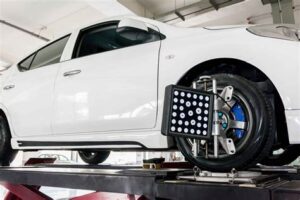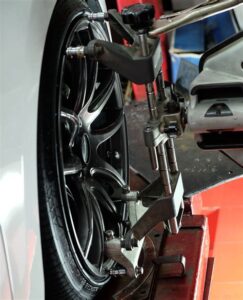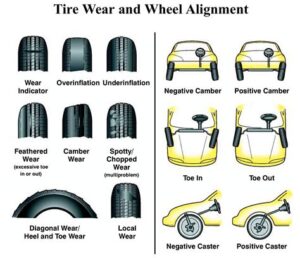Keeping your vehicle in top shape is essential for both safety and performance, yet many drivers overlook the importance of regular car alignments. Misalignment can lead to uneven tire wear, decreased fuel efficiency, and compromised handling. In this article, we will explore the critical questions surrounding car alignments, such as how often they should be checked and the signs indicating service is needed. Additionally, we’ll delve into the factors that influence alignment frequency and highlight the numerous benefits that come from keeping your wheels properly aligned. Join us as we uncover the essentials of vehicle alignment and ensure your ride remains smooth and safe on the road.
Understanding What Car Alignment Is and Its Importance
Car alignment refers to the adjustment of a vehicle’s suspension system, ensuring that all four wheels are positioned correctly in relation to each other and to the road. This process involves aligning the wheels with the manufacturer’s specifications concerning angles such as camber, caster, and toe. Proper alignment is crucial for a number of reasons:
| Importance | Benefits |
|---|---|
| Improved Handling | Enhances overall driving experience, making the car easier to steer and control. |
| Even Tire Wear | Prevents uneven tire wear, extending the life of your tires and saving you money. |
| Fuel Efficiency | Maintains optimal fuel consumption by reducing rolling resistance from misaligned wheels. |
| Safety | Ensures better stability and traction, reducing the risk of accidents. |
Understanding how alignment works and its importance can help vehicle owners make informed decisions regarding maintenance. It is vital to regularly assess your vehicle’s alignment and adhere to recommended services to ensure optimal performance, safety, and longevity of your car.
In answering the question of how often a car needs an alignment, several factors come into play, which will be discussed in the subsequent sections.
How Often Should You Check Your Car’s Alignment?
Maintaining proper wheel alignment is crucial for the overall performance and longevity of your vehicle. But how often should you check your car’s alignment? How often you need an alignment can depend on several factors, including your driving habits, road conditions, and the type of vehicle you own.
As a general rule of thumb, it’s advisable to check your car’s alignment at least once a year or every 12,000 miles. However, if you frequently drive on rough or uneven roads, or if you tend to hit potholes often, you should consider checking your alignment more frequently, possibly every 5,000 to 7,000 miles.
Additionally, you should also have your alignment checked if you notice any of the following:
- Uneven tire wear
- Your steering wheel is off-center when driving straight
- Your car pulls to one side
- Excessive vibration in the steering wheel
It’s essential to consult with a professional mechanic who can assess your vehicle and recommend the best maintenance schedule. Regular checks can save you from costly repairs down the line and enhance your driving experience.
Signs That Indicate Your Car Needs An Alignment
Recognizing the signs that your vehicle needs an alignment is crucial for maintaining not just performance, but also safety on the road. Here are several clear indicators that it’s time to check your car’s alignment:
- Uneven Tire Wear: If you notice that one side of your tires is worn down more than the other, this could indicate a misalignment.
- Vehicle Pulling to One Side: If your car tends to drift to the left or right when driving on a straight road, it’s a strong sign of alignment issues.
- Steering Wheel Off-Center: When your steering wheel is not centered while driving straight, this points to an alignment problem.
- Squealing Tires: If you hear a squealing sound from your tires while turning, it may suggest a misalignment.
- Vibration in the Steering Wheel: Unexplained vibrations or shaking in the steering wheel can result from misaligned wheels.
It’s important to pay attention to these warning signs, as ignoring them can lead to further issues, increased tire wear, and compromised safety. Regular checks, as highlighted in the previous sections, will help ensure your vehicle remains in optimal condition.
Factors That Influence How Often You Need An Alignment
Understanding how often a car needs an alignment isn’t just about following a fixed schedule; various factors come into play. Here are some key considerations:
| Factor | Description |
|---|---|
| Driving Conditions | Frequent driving on rough or uneven roads can disrupt wheel alignment more often than regular highway driving. |
| Vehicle Age | Older vehicles may suffer from worn suspension components, making them more prone to misalignment. |
| Load Weight | Regularly carrying heavy loads can stress the suspension system and affect alignment. |
| Tire Type | Certain tire types may wear differently and thus could impact alignment needs. It’s essential to consider tire pressure and maintenance. |
| Accidents or Impact | If the vehicle hits a pothole, curb, or is involved in a collision, even minor, the alignment may be affected, necessitating a check. |
Keeping these factors in mind will help you determine how often you should schedule alignment checks. Regular assessments based on your driving habits can save you from expensive repairs down the line.
The Benefits of Regular Alignments for Your Vehicle’s Health
Maintaining your vehicle’s alignment is crucial for its overall health and performance. Regular alignments can lead to several benefits, ensuring your car remains safe and efficient on the road. Here are some key advantages:
- Improved Fuel Efficiency: When your wheels are properly aligned, your car does not have to work as hard to drive straight. This can significantly enhance fuel economy, allowing you to save money at the pump.
- Extended Tire Life: Misalignment can lead to uneven tire wear. By frequently checking your alignment, you can ensure your tires wear evenly, prolonging their lifespan and reducing the need for early replacements.
- Smoother Ride Quality: Regular alignments can contribute to a smoother driving experience, minimizing vibrations and enhancing handling. This can make a significant difference in your day-to-day driving comfort.
- Enhanced Safety: Proper alignment improves your vehicle’s stability and control. This can be especially critical in emergency braking situations, reducing the risk of accidents.
- Preventing Other Issues: Regular alignments can help you avoid other costly repairs down the line by preventing uneven wear on suspension components and steering systems.
Understanding how often you should be getting your vehicle aligned can lead to tremendous benefits, from financial savings on fuel and tires to overall safety improvements. Prioritizing regular alignments is a proactive way to maintain your vehicle in excellent condition.
Frequently Asked Questions
What is a car alignment?
A car alignment is an adjustment of the vehicle’s suspension system, ensuring that the wheels are set to the correct angles for optimal handling and tire wear.
How often should a car undergo an alignment check?
Generally, a car should have its alignment checked every 6,000 miles or during routine maintenance, but it can vary based on driving conditions and habits.
What are the signs that a car needs an alignment?
Signs include uneven tire wear, the vehicle pulling to one side, a steering wheel that is off-center, or vibrations in the steering wheel.
How can driving habits affect car alignment?
Aggressive driving, hitting potholes or curbs, and frequent sharp turns can cause misalignment, making it important to adjust alignment based on driving styles.
What is the difference between alignment and wheel balance?
Alignment refers to the angles of the wheels, while wheel balance involves ensuring that the weight of the wheel and tire is evenly distributed around the axle.
Can a car alignment improve fuel efficiency?
Yes, proper alignment reduces rolling resistance and tire drag, which can lead to improved fuel efficiency and lower overall operating costs.
What is the typical cost for a car alignment?
The cost can vary widely, typically ranging from $75 to $100, depending on the vehicle type and location, but it’s a worthwhile investment for vehicle maintenance.





